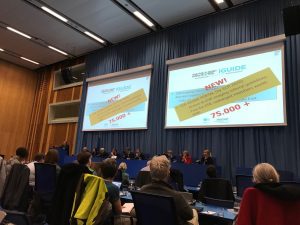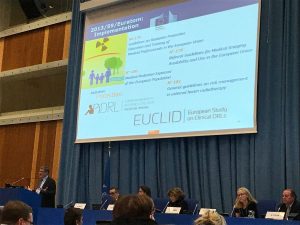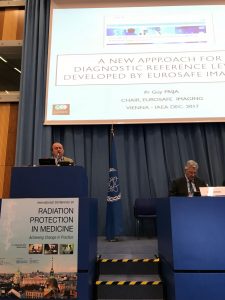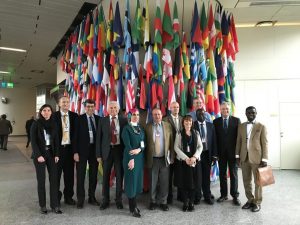ESR@Work January 2018
ESR strongly represented at the IAEA International Conference on Radiation Protection in Medicine
The ESR acted as a cooperating organisation of the IAEA International Conference on Radiation Protection in Medicine: Achieving Change in Practice held in Vienna, 11-15 December 2017.

The main aim of the conference was to review actions and developments since the 2012 Bonn conference, with a focus on progress in response to its Call for Action.
The conference reviewed the overall approach to the implementation of these actions and looked at how international organisations and other stakeholders can harmonise their actions for better impact. It also allowed stakeholders to discuss new developments affecting radiation protection in medicine.
For the ESR, the conference was a great opportunity to also take stock on its EuroSafe Imaging activities and achievements. In this regard, it has to be stressed in particular that the Imaging Call for Action in 2014 was issued as a response to the Bonn Call for Action. The EuroSafe Imaging Call for Action is currently under review and the updated call will be announced at the upcoming European Congress of Radiology (ECR) 2018. However, the need for a holistic, multi-stakeholder approach will still be the main priority to address the issue of medical radiation protection to healthcare professionals, patients and the public.
At the IAEA conference, the ESR was given the floor in the Briefing Session held right after the official opening. In this talk, Prof. Guy Frija, chair of EuroSafe Imaging presented the ESR in general, in particular the stunning number of members worldwide and their membership benefits, e.g. free access to publications and e-learning materials were highlighted. Thereafter, he focused his presentation on EuroSafe Imaging and highlighted that the initiative is providing comprehensive guidance and practical tools to support the implementation of the European Basic Safety Standards directive (2013/59/Euratom). EuroSafe Imaging was also presented with a poster at the conference. This session was also a great opportunity to announce the new ESR iGuide portal in order to raise awareness of the importance of the appropriate use of medical imaging in Europe and beyond.
The new, publicly accessible ESR iGuide portal solution, offering access to the ESR’s imaging referral guidelines through the stand-alone clinical decision support (CDS) tool will be available by ECR 2018. The announcement attracted wide attention at the IAEA conference, in particular as access to the portal is completely free until September 30, 2018. Thereafter, it will remain as a free-of-charge service for all ESR radiologist members, while other individuals can continue to access ESR iGuide through a subscription service.

Moreover, the ESR participated in the panel of the European Commission session, which focused at introducing the Euratom legal basis for radiation protection, presenting the progress and challenges encountered by Member Stats in implementing the new BSS Directive and discussing with different stakeholders the challenges and opportunities in the area of medical radiation protection. The session consisted of keynote talks by the European Commission and HERCA (Heads of European Radiological protection Competent Authorities) followed by a panel discussion with stakeholders. Prof. G. Frija, ESR representative, in particular welcomed the good collaboration with the European Commission and highlighted the need for a European policy for equipment update and the necessity to improve justification and optimisation concepts by bringing industry closer to healthcare providers.

Prof. G. Frija, also co-chair of the ISR Quality and Safety Alliance (ISRQSA), presented EuroSafe Imaging’s work in a session organised by the International Society of Radiology (ISR). He focused particularly on the need of developing a new concept for diagnostic reference levels (DRLs), whereby exposure protocols should be primarily based on clinical indications instead of anatomical locations. In addition, EuroSafe Imaging proposes using values of automatic dose collection and from dose management systems, as well as establishing local DRLs and nation-wide local, but interconnected repositories for calculating national DRLs. In this regard, the ESR is carrying out a European Commission tender project to establish clinical DRLs for x-ray medical imaging (EUCLID).

The ESR representatives Prof. R. Loose and Prof. G. Frija also contributed to the session on “Learning from unintended and accidental exposures in medicine”. Prof. Loose, chairperson of the ESR Subcommittee on Radiation Protection, talked on “Avoidance of incidents in radiological procedures”, and Prof. Frija gave a presentation on “What can non-radiotherapy users learn from radiotherapy?” focusing on CT in adults. He pointed that non-radiotherapy users can in particular learn about the process and culture of safety, the declaration and analyses of incidents and accidents, as well as the personalised approach. To support the learning process, he proposed developing educational programmes, establishing multi-stakeholder teams, clearly defining reportable medical radiation events as well as developing further research on low does effects of medical radiation exposure, as already carried out by the MEDIRAD project which was presented with a poster at the IAEA conference, as well as on artificial intelligence in radiation protection.

